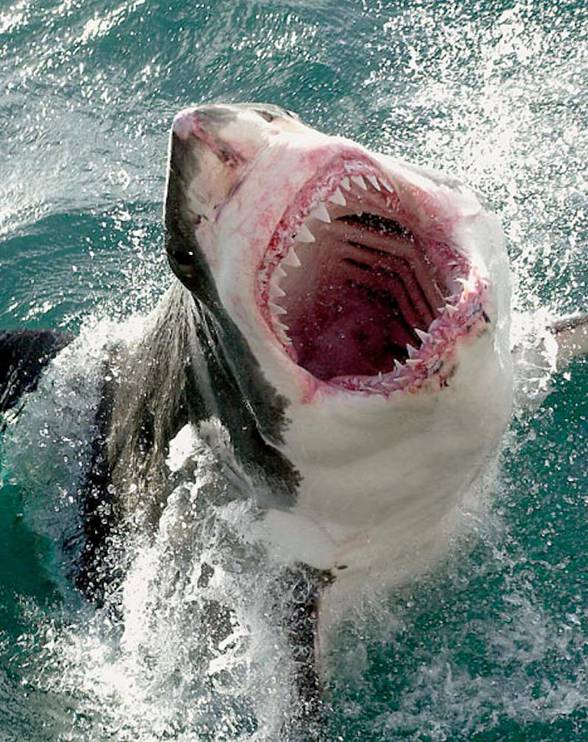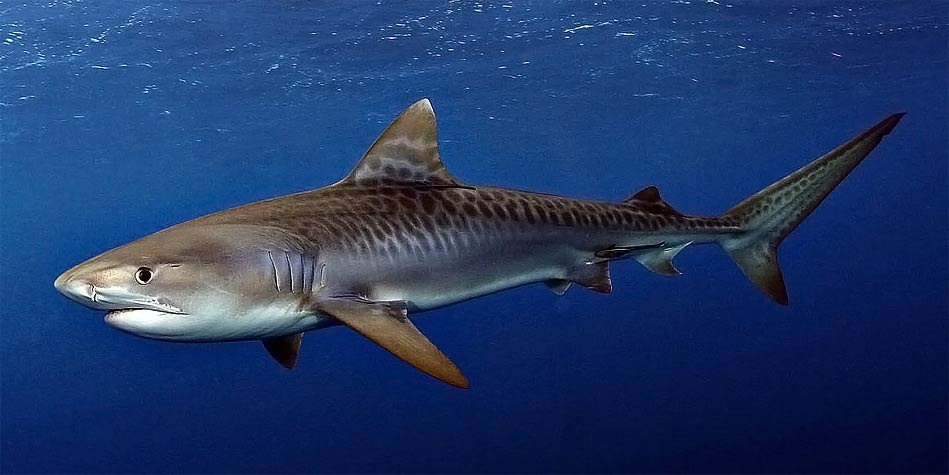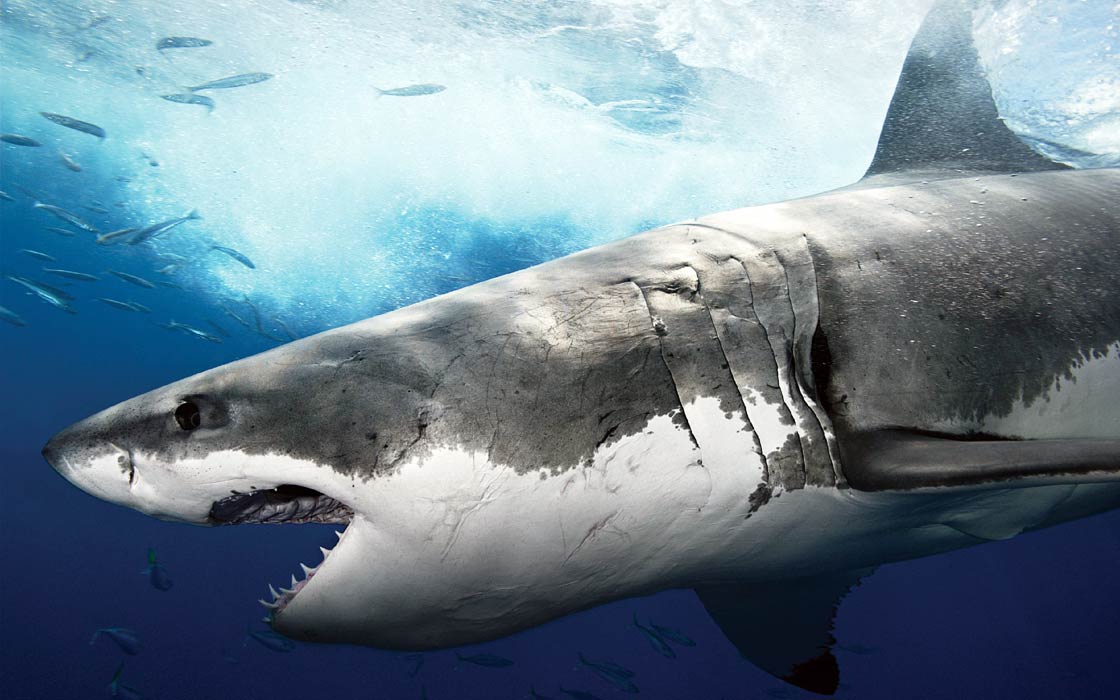The largest sharks – Top 10
Sharks have always fascinated people. Their murderous strength and formidable appearance, for years stimulate our imagination. We create myths around them and create movies about sharks. The bloodthirstiness of sharks captivates our imagination.
Now we present a ranking of the largest sharks of the modern world. Therefore, you will not find on the list the largest shark of all time – Megalodon that whales ate for breakfast :), because it already gave up the ghost for good 2.6 million years ago.
Even if you believe that the Megalodon is still alive, we ensure you that for a long time this shark is no longer on Earth.
Sharks have diversified into over 500 species. They range in size from the small dwarf lanternshark (Etmopterus perryi) of only 18 cm (7 in) in length, to sharks that reach over 12 m (40 ft) in length.
More about the sharks that prevail in the seas and oceans, you will learn from the article – Sharks, myths and facts.
The biggest sharks are the largest fish in the world.

The biggest / largest / longest sharks – Top 10
Rank 28-23
28. Sofa shark (Pseudotriakis microdon) – 3.0 m (9.8 ft)
The Sofa Shark (Pseudotriakis microdon) is a species of shark that belongs to the family Pseudotriakidae. It is also known as the False Catshark or the Pelagic Catshark. This species is found in deep, offshore waters in the Atlantic, Pacific, and Indian Oceans.
The Sofa Shark is a large, predatory shark that can grow up to 3.0 m (9.8 ft) in length and weigh over 35 kg (77 lbs). It has a slender, streamlined body with a long, pointed snout and sharp, serrated teeth. Its skin is brown or grey in color, with a white underside.
The Sofa Shark is a predatory shark that feeds on a wide range of prey, including fish, cephalopods, and other sharks. It is found in a variety of habitats, including deep, offshore waters, as well as in the open ocean.
The Sofa Shark is potentially dangerous to humans, but unprovoked attacks are rare. It is classified as Data Deficient by the International Union for Conservation of Nature (IUCN) due to a lack of information about its biology and ecology. More research is needed to better understand this species and its role in the ecosystem.
It is a slender, dark brown shark and is a maximum of 2.69 m /8.8 ft/ (males) to 2.95 m /9.7 ft/ (females) long. The lower lobe of the caudal fin is only slightly developed. It Inhabits all oceans at depths from 200 to 1,500 m (656 – 4,920 ft).
27. Indian Sand Tiger Shark (Carcharias tricuspidatus) – 3.2 m (10.5 ft)
In the sand tiger sharks, the females reach a maximum length of 320 cm (10.5 ft). The males remain smaller with a maximum body length of 260 cm (8.5 ft). In general, adult fish have a length of 2 to 2.2 meters (6.6 – 7.2 ft). Externally, the sexes hardly differ. They have a pointed, flattened snout and small eyes relative to the body. They have no pitch to protect the eyes. The long pointed teeth are directed strongly forward. The sand tiger sharks are perfectly adapted to the sea sand bottom by the top color and the pattern. Characteristic are the yellow to dark red spots on the elongated, strong, yellowish body, which become paler with age. The ventral side is white. The two dorsal fins, of which the front is offset relatively far to the rear, are the same size.
26. Pelagic Thresher (Alopias pelagicus) – 3.8 m (12.47 ft)
The Pacific fox shark is a large shark with a maximum body length of about 380 cm (12.47 ft). It has a dark blue to blue-violet back color without conspicuous drawing and a white belly color, which does not extend beyond the ventral fins. The shark has a conically rounded snout and relatively small eyes compared to other fox sharks. The caudal fin is very large and the upper tail lobus has a length that is almost equal to the rest of the body. The shark has a small anal fin and two dorsal fins. The first dorsal fin is significantly larger than the second and lies behind the pectoral fins. The pectoral fins are relatively large and do not end sharply like the common fox shark. Like all species of the genus, these sharks have five gill slits.
25. Blue Shark (Prionace glauca) – 3.83 m (12.57 ft)
The blue shark usually reaches a body length of about 340 cm (11.2 ft), but in individual cases can also be significantly larger. For example, the longest blue shark ever measured had a length of 383 cm (12.6 ft) and unconfirmed reports even speak of animals over 4.5 meters (14.8 ft) in length. The maximum known body weight of a blue shark was 205.9 kg (454 lb). The back of these sharks and the tops of the fins are bright dark blue and thus eponymous for the species. The belly and the bottom of the fins are white and at the fin tips the animals are black. Compared to other requiem sharks, the first dorsal fin is shifted much farther back and the pectoral fins are long and sickle-shaped. The caudal fin is medium in size compared to other sharks and small keels are found on the tail root.
24. Oceanic Whitetip Shark (Carcharhinus longimanus) – 4.0 m (13.12 ft)
With a body length of up to 400 cm (13.1 ft), the Oceanic Whitetip Shark is one of the largest sharks, but rarely reaches more than 300 cm (9.8 ft) in length. The average lengths are 180 to 190 cm (5.9 – 6.2 ft). Females are usually slightly larger than males. It has a maximum weight of almost 170 kilograms (375 lb), the heaviest known animal weighed 167.5 kg (369 lb). The species has the shark’s typical physique, which is often formed by a slight hump.
23. Prickly Shark (Echinorhinus cookei) – 4.0 m (13.12 ft)
Prickly Shark is a large shark – average size about 3 meters (9.8 ft), maximum size about 4 meters (13.1 ft) with two tail fins offset to the tail without fin sting. The thorn shark got its name because of flat thorn-like skin denticles, which are located on the body and the fins. The second dorsal fin starts slightly before the end of the ventral fins, the anal fin is missing. The head is flattened with small suction holes. The fifth gill slit is significantly larger than the other four. The body has a predominantly brown color.

Rank 22-17
22. Humpback Cat Shark (Apristurus gibbosus) – 4.1 (13.45 ft)
The Humpback Cat Shark (Apristurus gibbosus) is a species of deep-sea shark that belongs to the family Scyliorhinidae. It is also known as the Humpback Catshark or the Humped Catshark.
This shark is found in the Western Pacific Ocean, including the waters around Japan, China, and Korea, as well as in the eastern Indian Ocean. It is a small shark, typically reaching a maximum length of about 50 cm (20 inches).
The Humpback Cat Shark has a slender, streamlined body with a long, tapering tail. Its skin is smooth and has a brown or gray coloration. It has a distinctive hump on its back, which gives it its common name.
This species is found at depths of around 500 to 1,000 meters (1,600 to 3,300 feet) and is thought to be a slow-moving, bottom-dwelling shark. It is believed to feed on small fish, crustaceans, and cephalopods.
Little is known about the biology and behavior of the Humpback Cat Shark, as it is a poorly studied species that is difficult to observe in its deep-sea habitat. However, it is not considered to be a threat to humans and is not considered to be endangered.
21. Bumpytail ragged-tooth (Odontaspis ferox) – 4.1 m (13.5 ft)
The Bumpytail Ragged-tooth Shark, also known as the Bumpytail Sand Tiger Shark or the Rufous Sand Tiger Shark (Odontaspis ferox), is a species of shark that belongs to the family Odontaspididae. It is found in the western and central Indian Ocean, including the waters around South Africa, Mozambique, and Madagascar.
The Bumpytail Ragged-tooth Shark is a medium-sized shark, typically reaching a maximum length of around 3 meters (10 feet). It has a robust, muscular body with a long, pointed snout and large, triangular teeth. Its skin is covered in small, rough scales, giving it a rough, bumpy appearance. The shark’s common name refers to the bumps on its tail, which are used to detect vibrations in the water.
This species is found in shallow, coastal waters and prefers sandy or muddy bottoms. It is a slow-moving, bottom-dwelling shark that feeds on a variety of prey, including fish, crustaceans, and cephalopods.
The Bumpytail Ragged-tooth Shark is not considered to be a threat to humans and is not considered to be endangered. However, it is vulnerable to overfishing and habitat loss, and populations of this species may be declining in some areas.
20. Smalltooth Sand Tiger Shark (Odontaspis ferox) – 4.1 m (13.45 ft)
The Smalltooth Sand Tiger Shark (Odontaspis ferox) is a species of shark that belongs to the family Odontaspididae. It is also known as the Smalltooth Ragged-tooth Shark or the Grey Nurse Shark. This species is found in the western and central Indian Ocean, including the waters around South Africa, Mozambique, and Madagascar.
The Smalltooth Sand Tiger Shark is a medium-sized shark, typically reaching a maximum length of around 3 meters (10 feet). It has a robust, muscular body with a long, pointed snout and large, triangular teeth. Its skin is covered in small, rough scales, giving it a rough, bumpy appearance.
This species is found in shallow, coastal waters and prefers sandy or muddy bottoms. It is a slow-moving, bottom-dwelling shark that feeds on a variety of prey, including fish, crustaceans, and cephalopods.
The Smalltooth Sand Tiger Shark is not considered to be a threat to humans and is not considered to be endangered. However, it is vulnerable to overfishing and habitat loss, and populations of this species may be declining in some areas.
19. Dusky Shark (Carcharhinus obscurus) – 4.20 m (13.78 ft)
The Dusky Shark (Carcharhinus obscurus) is a species of shark that belongs to the family Carcharhinidae. It is also known as the Brown Shark or the Dusky Whaler. This species is found in tropical and temperate waters around the world, including the Atlantic, Pacific, and Indian Oceans.
The Dusky Shark is a large shark, typically reaching a maximum length of around 4 meters (13 feet) and weighing up to 350 kg (770 lbs). It has a slender, streamlined body with a long, pointed snout and large, serrated teeth. Its skin is grey or brown in color, with a white underside.
This species is found in a variety of habitats, including shallow, coastal waters, as well as in the open ocean. It is a versatile predator that feeds on a wide range of prey, including fish, cephalopods, and other sharks.
The Dusky Shark is considered to be potentially dangerous to humans, but unprovoked attacks are rare. It is classified as Near Threatened by the International Union for Conservation of Nature (IUCN) due to overfishing and habitat loss.
18. Longfin Mako Shark (Isurus paucus) – 4.3 m (14.11 ft)
The Longfin Mako Shark is a species of mackerel shark that belongs to the family Lamnidae, and it is found in temperate and tropical waters around the world. It is a relatively uncommon species and is often lumped together with the Shortfin Mako Shark (Isurus oxyrinchus), which is a more widely recognized and studied species.
The Longfin Mako Shark is a pelagic species that is found in moderately deep water, typically at depths of around 200 to 300 meters (660 to 980 feet). It has a sleek, streamlined body with a long, pointed snout and sharp, triangular teeth. Its skin is blue-gray or dark blue in color, with a white underside. The Longfin Mako Shark is known for its speed and agility and is considered to be one of the fastest sharks in the world.
This species is potentially dangerous to humans, but unprovoked attacks are rare. It is classified as Endangered by the International Union for Conservation of Nature (IUCN) due to overfishing and habitat loss.
17. Nurse Shark (Ginglymostoma cirratum) – 4.30 m (14.11 ft)
The Nurse Shark (Ginglymostoma cirratum) is a species of shark that belongs to the family Ginglymostomatidae. It is found in tropical and subtropical waters of the western Atlantic Ocean, including the Gulf of Mexico, Caribbean Sea, and the eastern Pacific Ocean.
The Nurse Shark is a medium-sized shark, typically reaching a maximum length of around 4 meters (13 feet). It has a stocky, bulky body with a short, rounded snout and small, triangular teeth. Its skin is smooth and typically brown or gray in color, with pale spots or blotches.
This species is found in a variety of habitats, including shallow, coastal waters, as well as in coral reefs and rocky bottoms. It is a nocturnal predator that feeds on a wide range of prey, including fish, crustaceans, and cephalopods.
The Nurse Shark is not considered to be a threat to humans and is not considered to be endangered. However, it is vulnerable to overfishing and habitat loss, and populations of this species may be declining in some areas.

Rank 16-11
16. Scalloped Hammerhead Shark (Sphyrna lewini) – 4.30 m (14.11 ft)
The Scalloped Hammerhead Shark (Sphyrna lewini) is a species of shark that belongs to the family Sphyrnidae. It is found in tropical and subtropical waters around the world, including the Atlantic, Pacific, and Indian Oceans.
The Scalloped Hammerhead Shark is a large shark, typically reaching a maximum length of around 4 meters (13 feet) and weighing up to 400 kg (880 lbs). It is named for its distinctive hammer-shaped head, which is scalloped along the edges. It has a slender, streamlined body with a long, pointed snout and large, serrated teeth. Its skin is grey or brown in color, with a white underside.
This species is found in a variety of habitats, including shallow, coastal waters, as well as in the open ocean. It is a predatory shark that feeds on a wide range of prey, including fish, cephalopods, and other sharks.
The Scalloped Hammerhead Shark is considered to be potentially dangerous to humans, but unprovoked attacks are rare. It is classified as Endangered by the International Union for Conservation of Nature (IUCN) due to overfishing and habitat loss. Populations of this species have declined significantly in recent years, and it is now considered to be at risk of extinction.

15. Pacific Sleeper Shark (Somniosus pacificus) – 4.40 m (14.44 ft)
The Pacific Sleeper Shark (Somniosus pacificus) is a species of shark that belongs to the family Somniosidae. It is also known as the Pacific Dogfish, the Pacific Dogshark, or the Northern Sleeper Shark. This species is found in the North Pacific Ocean, including the waters around Japan, Russia, and the United States.
The Pacific Sleeper Shark is a large, slow-moving shark that can grow up to 6 meters (20 feet) (unconfirmed) in length and weigh over 500 kg (1,100 lbs). It has a long, cylindrical body with a pointed snout and small, triangular teeth. Its skin is smooth and typically brown or grey in color, with a white underside.
This species is found in a variety of habitats, including shallow, coastal waters, as well as in the open ocean. It is a predatory shark that feeds on a wide range of prey, including fish, cephalopods, and other sharks.
The Pacific Sleeper Shark is not considered to be a threat to humans and is not considered to be endangered. However, it is vulnerable to overfishing and habitat loss, and populations of this species may be declining in some areas.
14. Whitley’s sleeper shark (Somniosus antarcticus) – 4.40 m (14.44 ft)
The Whitley’s Sleeper Shark (Somniosus antarcticus) is a species of shark that belongs to the family Somniosidae. It is also known as the Southern Sleeper Shark or the Antarctic Sleeper Shark. This species is found in the Southern Ocean, including the waters around Antarctica and the Southern Atlantic, Indian, and Pacific Oceans.
The Whitley’s Sleeper Shark is a large, slow-moving shark that can grow up to 4.4 meters (14 feet) in length and weigh over 1,000 kg (2,200 lbs). It has a long, cylindrical body with a pointed snout and small, triangular teeth. Its skin is smooth and typically brown or grey in color, with a white underside.
The Whitley’s Sleeper Shark is a predatory shark that feeds on a wide range of prey, including fish, cephalopods, and other sharks. It is found in a variety of habitats, including shallow, coastal waters, as well as in the open ocean.
This species is found in a variety of habitats, including shallow, coastal waters, as well as in the open ocean. It is a predatory shark that feeds on a wide range of prey, including fish, cephalopods, and other sharks.
The Whitley’s Sleeper Shark is not considered to be a threat to humans and is not considered to be endangered. However, it is vulnerable to overfishing and habitat loss, and populations of this species may be declining in some areas.
13. Shortfin Mako Shark (Isurus oxyrinchus) – 4.45 m (14.6 ft)
The Shortfin Mako Shark (Isurus oxyrinchus) is a species of shark that belongs to the family Lamnidae. It is also known as the Blue Pointer or the Bonito Shark. This species is found in temperate and tropical waters around the world, including the Atlantic, Pacific, and Indian Oceans.
The Shortfin Mako Shark is a large, pelagic shark that can grow up to 4 meters (13 feet) in length and weigh 500 kg (1,100 lbs). It has a sleek, streamlined body with a long, pointed snout and sharp, triangular teeth. Its skin is blue-gray or dark blue in color, with a white underside. The Shortfin Mako Shark is known for its speed and agility and is considered to be one of the fastest sharks in the world.
This species is a predatory shark that feeds on a wide range of prey, including fish, cephalopods, and other sharks. It is found in a variety of habitats, including shallow, coastal waters, as well as in the open ocean.
The Shortfin Mako Shark is potentially dangerous to humans, but unprovoked attacks are rare. It is classified as Endangered by the International Union for Conservation of Nature (IUCN) due to overfishing and habitat loss. Populations of this species have declined significantly in recent years, and it is now considered to be at risk of extinction.
12. Bluntnose Sixgill Shark (Hexanchus griseus) – 4.80 m (15.75 ft)
The Bluntnose Sixgill Shark (Hexanchus griseus) is a species of shark that belongs to the family Hexanchidae. It is also known as the Cow Shark or the Grey Shark. This species is found in the Atlantic, Pacific, and Indian Oceans, as well as in the Mediterranean Sea.
The Bluntnose Sixgill Shark is a large, slow-moving shark that can grow up to 20 ft (6.1 m) in length and weigh over 1,000 kg (2,200 lb) in weight. It has a broad, stocky body with a short, blunt snout and small, triangular teeth. Its skin is grey or brown in color, with a white underside. It is named for the six gill slits on the underside of its head, which is a characteristic shared by all members of the family Hexanchidae.
This species is found in a variety of habitats, including shallow, coastal waters, as well as in the open ocean. It is a predatory shark that feeds on a wide range of prey, including fish, cephalopods, and other sharks.
The Bluntnose Sixgill Shark is not considered to be a threat to humans and is not considered to be endangered. However, it is vulnerable to overfishing and habitat loss, and populations of this species may be declining in some areas.
11. Bigeye Thresher Shark (Alopias superciliosus) – 4.90 m (16.08 ft)
The Bigeye Thresher Shark (Alopias superciliosus) is a species of shark that belongs to the family Alopiidae. It is also known as the Bigeye Thresher or the Bigeye Fox Shark. This species is found in temperate and tropical waters around the world, including the Atlantic, Pacific, and Indian Oceans.
The Bigeye Thresher Shark is a large, pelagic shark that can grow up to 5 meters (16 feet) in length and weigh over over 300 kg (660 lbs). It is named for its large, protruding eyes, which are adapted for hunting in deep, low-light environments. It has a slender, streamlined body with a long, pointed snout and large, serrated teeth. Its skin is blue-gray or brown in color, with a white underside. The Bigeye Thresher Shark is known for its long, whip-like tail, which it uses to herd and stun its prey.
This species is a predatory shark that feeds on a wide range of prey, including fish, cephalopods, and other sharks. It is found in a variety of habitats, including shallow, coastal waters, as well as in the open ocean.
The Bigeye Thresher Shark is potentially dangerous to humans, but unprovoked attacks are rare. It is classified as Vulnerable by the International Union for Conservation of Nature (IUCN) due to overfishing and habitat loss. Populations of this species have declined significantly in recent years, and it is now considered to be at risk of extinction.

Rank 10-6
10. Smooth Hammerhead Shark (Sphyrna zygaena) – 5.00 m (16 ft)
The Smooth Hammerhead Shark (Sphyrna zygaena) is a species of shark that belongs to the family Sphyrnidae. It is also known as the Smooth Hammerhead, the Round Hammerhead, or the Common Hammerhead. This species is found in temperate and tropical waters around the world, including the Atlantic, Pacific, and Indian Oceans.
The Smooth Hammerhead Shark is a medium-sized shark that can grow up to 5 meters (16 feet) in length and weigh over 400 kg (880 lbs). It is named for its distinctive hammer-shaped head, which is wider than its body and has a rounded, smooth edge. It has a sleek, streamlined body with a long, pointed snout and sharp, triangular teeth. Its skin is grey or brown in color, with a white underside.
This species is a predatory shark that feeds on a wide range of prey, including fish, cephalopods, and other sharks. It is found in a variety of habitats, including shallow, coastal waters, as well as in the open ocean.
The Smooth Hammerhead Shark is potentially dangerous to humans, but unprovoked attacks are rare. It is classified as Endangered by the International Union for Conservation of Nature (IUCN) due to overfishing and habitat loss. Populations of this species have declined significantly in recent years, and it is now considered to be at risk of extinction.

9. Tiger shark (Galeocerdo cuvier) – 5.50 m (18.04 ft)
The Tiger Shark (Galeocerdo cuvier) is a species of shark that belongs to the family Carcharhinidae. It is also known as the Sea Tiger, the Estuary Shark, or the Zebra Shark. This species is found in tropical and subtropical waters around the world, including the Atlantic, Pacific, and Indian Oceans.
The Tiger Shark is a large, predatory shark that can grow up to 5 meters (16 feet) in length and weigh over 500 kg (1,100 lbs). It is named for the distinctive, vertical stripes on its skin, which fade as the shark matures. It has a long, slender body with a broad, blunt snout and sharp, serrated teeth. Its skin is blue-gray or brown in color, with a white underside.
The Tiger Shark is a voracious predator that feeds on a wide range of prey, including fish, cephalopods, birds, and other sharks. It is found in a variety of habitats, including shallow, coastal waters, as well as in the open ocean.
The Tiger Shark is potentially dangerous to humans, but unprovoked attacks are rare. It is classified as Near Threatened by the International Union for Conservation of Nature (IUCN) due to overfishing and habitat loss. Populations of this species have declined in some areas, but are stable or increasing in others.

8. Megamouth shark (Megachasma pelagios) – 5.50 m (18.04 ft)
The Megamouth Shark (Megachasma pelagios) is a species of shark that belongs to the family Megachasmidae. It is also known as the Megamouth, the Megamouth Whale Shark, or the Megamouth Whale. This species is found in tropical and temperate waters around the world, including the Atlantic, Pacific, and Indian Oceans.
The Megamouth Shark is a large, pelagic shark that can grow up to 5 meters (16 feet) in length and weigh over 1,000 kg (2,200 lbs). It is named for its distinctive, large mouth, which is lined with long, toothless jaws and over 50 rows of small, needle-like teeth. It has a long, slender body with a pointed snout and large, rounded pectoral fins. Its skin is dark brown or black in color, with a white underside.
The Megamouth Shark is a filter feeder that feeds on small, planktonic organisms, such as krill and copepods. It is found in a variety of habitats, including shallow, coastal waters, as well as in the open ocean.
The Megamouth Shark is a rare and little-known species, with only around 100 confirmed sightings worldwide. It is not considered to be a threat to humans and is not considered to be endangered. However, it is vulnerable to overfishing and habitat loss, and its populations may be declining in some areas.
7. Great Hammerhead Shark (Sphyrna mokarran) – 6.10 m (20.01 ft)
The Great Hammerhead Shark (Sphyrna mokarran) is a species of shark that belongs to the family Sphyrnidae. It is also known as the Great Hammerhead, the Squat-Headed Hammerhead, or the Bonnethead. This species is found in tropical and subtropical waters around the world, including the Atlantic, Pacific, and Indian Oceans.
The Great Hammerhead Shark is a large, predatory shark that can grow up to 6 meters (20 feet) in length and weigh over 500 kg (1,100 lbs). It is named for its distinctive hammer-shaped head, which is wider than its body and has a squared-off, serrated edge. It has a sleek, streamlined body with a long, pointed snout and sharp, triangular teeth. Its skin is grey or brown in color, with a white underside.
The Great Hammerhead Shark is a predatory shark that feeds on a wide range of prey, including fish, cephalopods, and other sharks. It is found in a variety of habitats, including shallow, coastal waters, as well as in the open ocean.
The Great Hammerhead Shark is potentially dangerous to humans, but unprovoked attacks are rare. It is classified as Endangered by the International Union for Conservation of Nature (IUCN) due to overfishing and habitat loss. Populations of this species have declined significantly in recent years, and it is now considered to be at risk of extinction.
6. Goblin shark (Mitsukurina owstoni) – 6.2 m (20.34 ft)
The Goblin Shark (Mitsukurina owstoni) is a species of shark that belongs to the family Mitsukurinidae. It is also known as the Goblin, the Demon Shark, or the Vampire Shark. This species is found in deep, offshore waters around the world, including the Atlantic, Pacific, and Indian Oceans.
The Goblin Shark is a rare and poorly-understood species, with only a few hundred specimens having been recorded worldwide. It is a deep-sea shark that can grow up to 4 meters (13 feet) in length and weigh over 300 kg (660 lbs), though it can grow considerably larger, with some individuals reaching 6 meters (20 feet) in length. It is named for its distinctive, goblin-like appearance, with a long, pointed snout and protruding, blade-like teeth. Its skin is pink or red in color, with a white underside.
The Goblin Shark is a predatory shark that feeds on a wide range of prey, including fish, cephalopods, and other sharks. It is found in a variety of habitats, including deep, offshore waters, as well as in the open ocean.
The Goblin Shark is not considered to be a threat to humans and is not considered to be endangered. However, it is vulnerable to overfishing and habitat loss, and its populations may be declining in some areas. It is also poorly understood and much more research is needed to better understand this species and its role in the ecosystem.

Rank 5-1
5. Common Thresher Shark (Alopias vulpinus) – 6.50 m (21.33 ft)
The Common Thresher Shark (Alopias vulpinus) is a species of shark that belongs to the family Alopiidae. It is also known as the Thresher, the Fox Shark, or the Swivel-Tail Shark. This species is found in temperate and tropical waters around the world, including the Atlantic, Pacific, and Indian Oceans.
The Common Thresher Shark is a large, predatory shark that can grow up to 6 meters (20 feet) in length and weigh over 400 kg (880 lbs). It is named for its distinctive, long, whip-like tail, which it uses to herd and stun its prey. It has a slender, streamlined body with a long, pointed snout and sharp, serrated teeth. Its skin is blue-gray or brown in color, with a white underside.
The Common Thresher Shark is a predatory shark that feeds on a wide range of prey, including fish, cephalopods, and other sharks. It is found in a variety of habitats, including shallow, coastal waters, as well as in the open ocean.
The Common Thresher Shark is potentially dangerous to humans, but unprovoked attacks are rare. It is classified as Vulnerable by the International Union for Conservation of Nature (IUCN) due to overfishing and habitat loss. Populations of this species have declined significantly in recent years, and it is now considered to be at risk of extinction.

4. Greenland Shark (Somniosus microcephalus) – 7.30 m (23.95 ft)
The Greenland Shark (Somniosus microcephalus) is a species of shark that belongs to the family Somniosidae. It is also known as the Gray Shark, the Sleeper Shark, the Ground Shark or gurry shark. This species is found in cold, deep waters in the North Atlantic Ocean, including around Greenland, Iceland, and Canada.
The Greenland Shark is a large, predatory shark that can grow up to 7 meters (23 feet) in length and weigh over 1,000 kg (2,200 lbs). It is named for its habitat in the waters around Greenland. It has a long, slender body with a pointed snout and sharp, triangular teeth. Its skin is grey or brown in color, with a white underside.
The Greenland Shark is a predatory shark that feeds on a wide range of prey, including fish, cephalopods, and other sharks. It is found in a variety of habitats, including deep, offshore waters, as well as in the open ocean.
The Greenland Shark is potentially dangerous to humans, but unprovoked attacks are rare. It is classified as Near Threatened by the International Union for Conservation of Nature (IUCN) due to overfishing and habitat loss. Populations of this species have declined in some areas, but are stable or increasing in others. It is also a long-lived species, with some individuals living over 400 years.

3. Great White Shark (Carcharodon carcharias) – 8.0 m (26.25 ft)
The Great White Shark (Carcharodon carcharias) is a species of shark that belongs to the family Lamnidae. It is also known as the White Shark, the Great White, or the White Pointer. This species is found in temperate and tropical waters around the world, including the Atlantic, Pacific, and Indian Oceans.
The Great White Shark is a large, predatory shark that can grow over 6 meters (20 feet) in length and weigh over 2,000 kg (4,400 lbs). It is named for its distinctive, white-colored skin and powerful, predatory behavior. It has a sleek, streamlined body with a long, pointed snout and sharp, serrated teeth. Its skin is blue-gray or brown in color, with a white underside.
The Great White Shark is a predatory shark that feeds on a wide range of prey, including fish, cephalopods, seals, and other sharks. It is found in a variety of habitats, including shallow, coastal waters, as well as in the open ocean.
The Great White Shark is potentially dangerous to humans, but unprovoked attacks are rare. It is classified as Vulnerable by the International Union for Conservation of Nature (IUCN) due to overfishing and habitat loss. Populations of this species have declined significantly in recent years, and it is now considered to be at risk of extinction. Despite its reputation as a ferocious predator, the Great White Shark plays a crucial role in maintaining the balance of marine ecosystems.

2. Basking Shark (Cetorhinus maximus) – 12.27 m (40.26 ft)
The Basking Shark (Cetorhinus maximus) is a species of shark that belongs to the family Cetorhinidae. It is also known as the Sunfish, the Bone Shark, or the Sailfish Shark. This species is found in temperate and tropical waters around the world, including the Atlantic, Pacific, and Indian Oceans.
The Basking Shark is a large, filter-feeding shark that can grow up to 12 meters (40 feet) in length and weigh over 5,000 kg (11,000 lbs). It is named for its distinctive, slow-moving behavior, which resembles that of a basking animal. It has a large, rounded body with a broad, flat snout and small, toothless jaws. Its skin is grey or brown in color, with a white underside.
The Basking Shark is a filter-feeder that feeds on small, planktonic organisms, such as krill and copepods. It is found in a variety of habitats, including shallow, coastal waters, as well as in the open ocean.
The Basking Shark is not considered to be a threat to humans and is not considered to be endangered. However, it is vulnerable to overfishing and habitat loss, and its populations may be declining in some areas. It is also a slow-growing and slow-reproducing species, which makes it more vulnerable to population declines. Despite its size, the Basking Shark is a gentle and docile species that poses no threat to humans.

1. Whale Shark (Rhiniodon typus) – 12.7 m (41.67 ft)
The Whale Shark (Rhincodon typus) is a species of shark that belongs to the family Rhincodontidae. It is also known as the Rhincodon, the Whale Shark, or the Filter Shark. This species is found in tropical and subtropical waters around the world, including the Atlantic, Pacific, and Indian Oceans.
The Whale Shark is a large, filter-feeding shark that can grow up to 12 meters (40 feet) in length and weigh over 20,000 kg (44,000 lbs). It is the largest fish species in the world and is named for its size and habitat in the open ocean, which is similar to that of whales. It has a large, rounded body with a broad, flat snout and small, toothless jaws. Its skin is grey or brown in color, with a white underside covered in distinctive white spots and stripes.
The Whale Shark is a filter-feeder that feeds on small, planktonic organisms, such as krill and copepods. It is found in a variety of habitats, including shallow, coastal waters, as well as in the open ocean.
The Whale Shark is not considered to be a threat to humans and is not considered to be endangered. However, it is vulnerable to overfishing and habitat loss, and its populations may be declining in some areas. It is also a slow-growing and slow-reproducing species, which makes it more vulnerable to population declines. Despite its size, the Whale Shark is a gentle and docile species that poses no threat to humans. It is often encountered by divers and is a popular target for ecotourism.

The largest shark ever lived was
Megalodon – 18 m (59 ft)
Megalodon (Otodus megalodon) was a species of shark that lived approximately 23 to 3.6 million years ago during the Cenozoic Era. It belonged to the family Otodontidae and is considered to be the largest predatory shark that has ever lived. Fossil evidence suggests that Megalodon was a massive shark that could grow up to 15 meters (50 feet) in length and weigh over 50,000 kg (110,000 lbs). It had a large, conical snout, sharp, triangular teeth, and a powerful, muscular body.
Megalodon was a top predator in the marine environment of its time, preying on a variety of large marine animals, including whales, dolphins, and seals. Its large size and powerful jaws would have enabled it to hunt and kill even the largest prey.
Megalodon is believed to have gone extinct approximately 2.6 million years ago, likely due to a combination of changing environmental conditions and competition with other species. It is not a species that is currently found in the modern marine environment.
Despite its popularity in popular culture, much of what is known about Megalodon comes from the study of fossilized teeth and vertebrae. There is still much that is unknown about this extinct species, and more research is needed to better understand its biology and behavior.




















Very interesting site
Very interesting site
i would like to visit here again
megalodon!!1!1!!!!!!1
Where’s the cow shark in this list? It is larger than the great white shark.